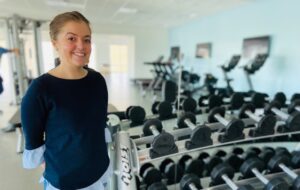By Lisa Farr, M.Ed. Director, Exercise Physiology Core Lab
Interview with doctoral candidate Kara Anderson and Arthur Weltman, Ph.D.
Ghrelin gained fame as “the hunger hormone” after its discovery just over 20 years ago. Produced by the stomach, ghrelin plays an important role in appetite, energy balance, and vascular health. Since its discovery in 1999, a lot has been learned about ghrelin, including that there are two types, each with differing actions. (one type suppresses appetite, reduces fat mass, and improves insulin sensitivity, whereas the other stimulates appetite, increases fat mass, and inhibits insulin release.) The two types of ghrelin can act synergistically, antagonize each other, and have independent effects. These different actions make it important to better understand ghrelin’s role in appetite, weight control, and glucose regulation, and how exercise impacts each type.
Exercise is one of the key lifestyle modifications recommended to people trying to lose weight, maintain weight loss, or stave off diabetes. But exercise guidelines tend to be pretty general, such as “move more and sit less.” And while there are important benefits when a person goes from doing nothing to doing something, when we are general about exercise we are not reaping its full benefits. It’s not the same “dose” for all conditions and all people. An easy analogy is this: If someone has high blood pressure, the type of medication they take matters. So does the dose.
This is true of exercise, including its effects on things like blood pressure, bone health, fitness, strength, weight loss, diabetes control, and regulatory hormones like ghrelin.
UVA Professor Arthur Weltman, his colleagues in Kinesiology, and doctoral student Kara Anderson recently received NIH funding to examine some of these questions. How does exercise of differing intensities effect ghrelin? Does this differ in subjects who are normal weight versus obese? Is this response different in subjects with normal glucose levels compared to those who have pre-diabetes?
Questions and Answers with Arthur Weltman, Ph.D and doctoral candidate Kara Anderson
Question
Why did you want to study the effect of exercise intensity on ghrelin?
Answer
Art: We are starting to realize that “exercise is medicine” but so far most of our guidelines about exercise are very general, whereas in the medical field there is a move towards “precision medicine.” While any exercise is better than none, we have increasingly realized that different exercise doses result in different outcomes…and that people will respond differently to different doses. So while most people are told basic things like “walk more” or “sit less”—and these things are beneficial—to see best results we need to be more specific. Some conditions might respond better to strength training than aerobic training, for example. And within the realm of aerobic training, high intensity training might be better than moderate training, depending on the outcome we are trying to improve.
Question
So what is the real-life application?
Answer
Depending on the findings, this might allow us to better tailor the exercise advice we give so that we help people see the health results they need or want. We are looking at the impact of exercise intensity on ghrelin and a whole host of related factors, not just appetite, but also vascular health, blood sugar, and even sleep…
Study Specifics
Normal weight and obese men and women who do not currently exercise will undergo screening labs and if enrolled will have a maximal exercise test on a stationary bike where the team will measure max heart rate, oxygen consumption, rating of perceived exertion, and a substrate in the blood called lactate. (Art: “Lactate tells us a lot about how hard someone is exercising. Once lactate begins to accumulate in the blood, people get fatigued pretty quickly.”)
Based on these test results the team will design two different exercise intensities. Subjects will return to the lab for these two sessions. They will burn 300 calories during each session but how they do it will differ—one session is longer duration but easier and the other is shorter and harder. The team will measure lactate, ghrelin, heart rate, and a number of other things during and after these sessions.
While catching up with Art and Kara we took the time to get a little personal too. Art has been a runner his entire life and has advised countless other runners on training and nutrition.
Question
Dr. Weltman, you’ve been a runner your entire life and have advised countless other runners on training and nutrition. What advice would you give your 25 year old runner self?
Answer
Start prioritizing strength training earlier probably
Question
Kara, what brought you into the field of exercise physiology? And specifically what made you interested in ghrelin?
Answer
I thought I would go to PT school, but when I was still an undergrad I realized how much I loved research and the intersection of nutrition and physiology. I made the switch from pre-PT to Exercise Physiology and attended graduate school at UNC-Chapel Hill before coming to UVA. Ghrelin interests me because while we know more about than we did 10 years ago, there’s still a lot to learn
Arthur Weltman, Ph. D, is the Faculty Director of the Exercise Physiology Core Lab and was responsible for its creation back in 1990. He holds a joint appointment in the Curry School of Education and the School of Medicine. He recently stepped down as the Chair of the Kinesiology Program, but continues to teach courses, mentor graduate students, and conduct research. In addition to the Ghrelin study, he is the UVA PI for a new multi-center Parkinson’s/exercise trial that is getting ready to begin.
Kara Anderson, who hails from Connecticut, is a Ph.D student in Exercise Physiology.
This study is IRB-HSR#UVA 200241 and is enrolling normal weight and obese individuals, between the ages of 18 and 55 who are not currently exercising.

